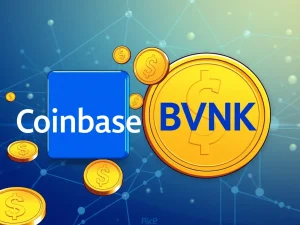Unlock Crypto Adoption: Why Standardization is Absolutely Essential Now

In the fast-evolving world of cryptocurrency and decentralized finance (DeFi), a crucial element is emerging as the key to widespread acceptance and robust growth: crypto standardization. Just as traditional markets thrive on established norms, the digital asset space is now recognizing the urgent need for unified frameworks. But why is crypto standardization so vital, and how will it pave the way for mainstream digital asset adoption? Let’s dive into the insightful opinions of Axel Schorn and Dr. Duc Au and explore the transformative power of bringing order to the crypto realm.
Why is Crypto Standardization Essential for Digital Asset Adoption?
Imagine navigating a global marketplace where every vendor uses a different measuring system and language. Chaos, right? This is akin to the current state of digital assets. Traditional financial markets have long benefited from standardized systems governing data flow, ensuring smooth trading, settlement, and regulatory compliance. These standards are the invisible backbone of trust and efficiency. Now, as DeFi and digital assets like cryptocurrencies and tokenized securities enter the scene, the absence of such crypto standardization poses a significant hurdle.
While the promise of digital assets is immense, the fragmented information landscape can actually hinder digital asset adoption. Platforms like CoinMarketCap and CoinGecko offer valuable data, but inconsistencies in market capitalization, supply figures, and other vital reference points create confusion and uncertainty. Think of it like this:
- Traditional Finance: Clear, consistent standards (like ISIN, CFI, FISN) ensure everyone is on the same page.
- Decentralized Finance (DeFi): Lack of universal standards leads to data discrepancies and hinders trust.
Fortunately, various global initiatives are underway, driven by private foundations and associations, all striving to bring much-needed crypto standardization to the forefront.
Drawing Inspiration: Traditional Frameworks as a Blueprint for Crypto Standards
We don’t need to reinvent the wheel. The success of traditional finance offers a clear guideline. Studies show that standards contribute billions to economies annually – a staggering €17 billion in Germany alone! For traditional assets, the International Organization for Standardization (ISO) provides a hierarchical system for unambiguous asset categorization. Let’s look at some key examples:
| Standard | Description | Purpose |
|---|---|---|
| ISIN (International Securities Identification Number) | Global standard for uniquely identifying financial instruments. | Ensures every financial instrument, from stocks to crypto securities, has a unique identifier. |
| CFI (Classification of Financial Instruments) | Internationally recognized system for classifying financial instruments. | Provides a consistent classification framework that remains unchanged throughout an instrument’s life. |
| FISN (Financial Instrument Short Name) | Standardized approach to short names and descriptions. | Offers a human-readable short format for key security information. |
National Numbering Agencies (NNAs) are crucial in this system, assigning ISIN, CFI, and FISN and maintaining a global database. For regions without NNAs, Substitute Numbering Agencies step in. Crucially, ISINs are technology-agnostic, applying to both paper and electronic forms, and importantly, tokenized instruments like crypto securities, as highlighted by Germany’s Electronic Securities Act.
Consider tokens with geographical links, like a security token issued in Germany. The German NNA will assign the ISIN. But what about tokens without a clear geographical origin, like Bitcoin (BTC)? In these cases, an ISIN with the prefix “XT” is assigned by Etrading Software. This helps identify the instrument even at the token level. Furthermore, data fields at the token level, such as token type, hash function, and generation mechanism, become increasingly relevant. For the instrument level, details like the token’s blockchain are essential. The Digital Token Identifier Foundation addresses this by providing the Digital Token Identifier (DTI, ISO 24165).
Key Takeaways: Theses on Crypto Standardization and its Future Impact
Several key working theses underscore the transformative potential of crypto standardization:
- Mandatory Crypto Identifiers: Just as ISINs are vital for traditional assets, unique identifiers for cryptocurrencies and tokenized securities are on the horizon. These identifiers will streamline tracking, trading, and reporting across exchanges and custody providers, enabling seamless integration with existing financial systems. This is a game-changer for digital asset adoption.
- Enhanced Transparency and Regulatory Compliance: As regulatory scrutiny intensifies, standardized data formats are becoming indispensable for compliance and risk management. Imagine simplified reporting and clearer audit trails – all thanks to crypto standardization.
- Global Coordination for Blockchain Interoperability: Crypto standardization isn’t a solo act; it requires global collaboration. Regulatory bodies and financial institutions worldwide must work together. International organizations will play a pivotal role in creating frameworks that ensure blockchain interoperability across jurisdictions, reducing market fragmentation and inconsistencies.
Initial strides have been made with ISO identifiers for digital assets. Coupled with EU-wide regulations like MiCA (Markets in Crypto-Assets), the industry is laying a solid foundation for wider digital asset adoption. The journey toward complete crypto standardization is ongoing. It remains to be seen how investors and crypto players will navigate the path ahead and overcome any roadblocks. But one thing is clear: crypto standardization is not just a technical necessity; it’s the key to unlocking the full potential of digital assets and fostering a secure, transparent, and globally accessible financial future.
Opinion by: Axel Schorn and Dr. Duc Au
This article is for general information purposes and is not intended to be and should not be taken as legal or investment advice. The views, thoughts, and opinions expressed here are the author’s alone and do not necessarily reflect or represent the views and opinions of Crypto News Insights.
#Bitcoin #Blockchain #Altcoin #Adoption #Digital Asset #Digital Asset Management







